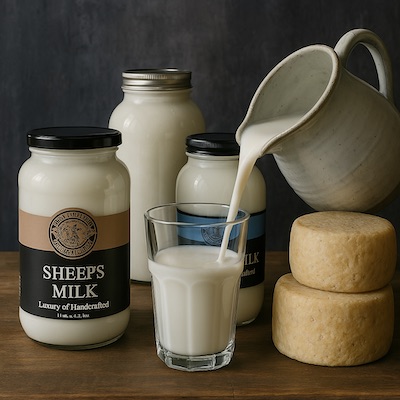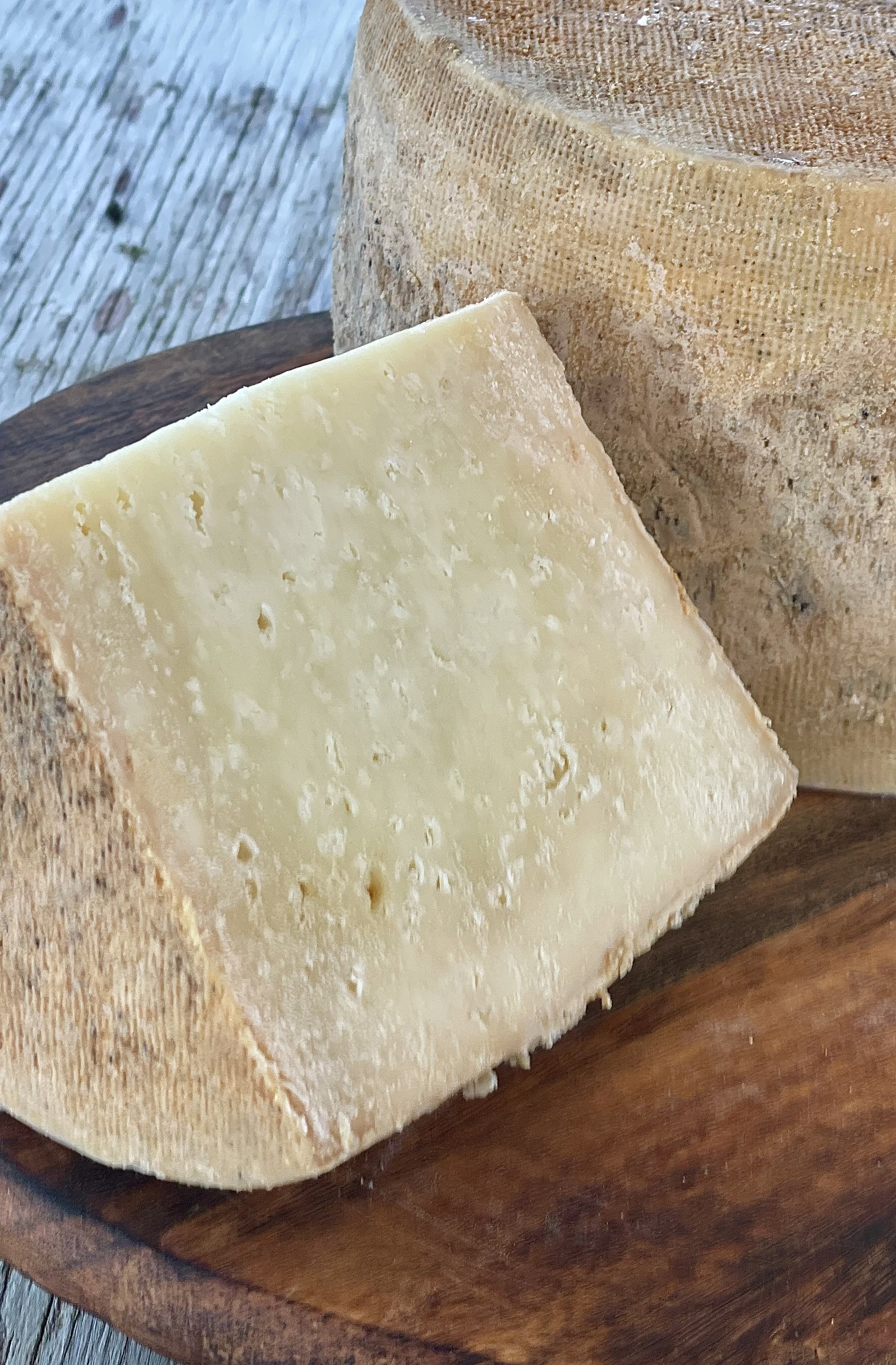All Pecorino cheeses owe their character to one ingredient: sheep’s milk. Sheep’s milk (from ewes) is quite different from the more commonly consumed cow’s milk – both in composition and impact on flavor and nutrition. Understanding its properties will shed light on why Pecorino tastes the way it does and even why it has certain health benefits. Let’s break down the nutritional profile of sheep’s milk and discuss its advantages:
- Rich in Protein and Fat: Sheep’s milk is notably richer in protein and butterfat than cow’s or goat’s milk. In a comparative study, sheep milk was found to have the highest protein and fat content among the three, whereas cow and goat milk had higher lactose (milk sugar) content.
Sheep’s milk delivers more cheese-making solids per volume, which helps explain why traditional cheesemakers in certain regions chose sheep over cows for making Pecorino. For example, while cow milk might be ~3.5% protein and ~3.5–4% fat, sheep’s milk often contains around 5-6% protein and 6-10% fat (values vary with breed and season). This density yields richer and creamier cheese (fat = flavor!) and also means higher cheese yield from a given quantity of milk. Pecorino’s concentrated richness – how it can taste so full-bodied and satisfying – is largely thanks to the high-fat/protein of ewe’s milk. This is unconditionally the best milk for cheese making. - Higher in Minerals (Calcium, Phosphorus, Magnesium, Zinc): Sheep’s milk packs a mineral punch. It contains significantly more calcium and phosphorus than cow’s milk. In one analysis, sheep’s milk had about 193 mg of calcium per 100g, compared to ~120 mg in cow’s milk. Calcium and phosphorus are vital for bone health, and they are present in bioavailable forms in cheese. Sheep milk is also a good source of magnesium and zinc, essential for immune function and metabolic health. A piece of Pecorino delivers a concentrated source of minerals because cheesemakers remove most of the water, making it one of the more nutrient-dense cheeses.
- Higher in Vitamins (especially B vitamins and A): You’ll find more certain vitamins in sheep’s milk. It has notably high levels of B vitamins like B12 and folate, as well as vitamin C and A (retinol). For instance, compared to goat and cow milk, sheep milk can have 3-5 times more folate and B12 in some studies. Vitamin B12 is crucial for nerve function and red blood cells, which vegetarians can lack if they don’t consume animal products – age kefir cheese like Pecorino can be a valuable source. The vitamin A in sheep’s milk (partly as retinol) contributes to vision and immune support; one source notes sheep milk as a significant source of retinol, unlike goat milk, which is low. During cheese aging, some vitamins like A and E (fat-soluble ones) remain in the fat, so Pecorino retains those benefits.
- Beneficial Fats (CLA and Omega fatty acids): Sheep’s milk fat contains a relatively high proportion of medium-chain fatty acids and conjugated linoleic acid (CLA). CLA has been researched for potential health benefits like anti-cancer and anti-diabetes effects, and sheep’s milk has more CLA than cow’s milk. Also, the flavor of sheep’s milk (that hint of “lanolin” or grassiness) comes from its unique fat composition – some find it delectable. From a health standpoint, moderate consumption of sheep dairy products provides these fats, which some studies suggest could be beneficial in metabolism.
- Easy to Digest Proteins: Many people who have difficulty digesting cow’s milk find sheep’s (and goat’s) milk to be more tolerable. One reason is the protein structure. All milk contains casein proteins, but the type of casein differs. Sheep and goat milk naturally lack the variant of beta-casein known as A1 and instead have mostly A2 beta-casein. Many cow breeds produce A1 beta-casein, which can release a peptide during digestion that researchers have linked to inflammation or discomfort in susceptible individuals. A2 beta-casein is considered the “easier to digest” form. In essence, sheep’s milk is an A2 milk. Making it potentially gentler on the gut for those sensitive to dairy proteins.
Additionally, sheep and goat milk have much lower levels of agglutinin (a protein that causes fat globules to cluster). Which may help the milk’s fat globules stay smaller and more digestible. People with lactose intolerance also sometimes tolerate sheep’s milk cheeses better. Not because sheep’s milk has less lactose. But because hard-aged kefir farmer cheese like Pecorino is naturally very low in lactose (bacteria consume the lactose during fermentation). - “Gentle” on the Stomach and Allergies: Beyond the A2 casein aspect, sheep’s milk is often a good alternative for those allergic to cow milk. While true milk protein allergies might cross-react (someone allergic to cow casein could be allergic to sheep/goat, too), many individuals experience sheep’s milk products as less allergenic. Anecdotally, and as highlighted by producers, sheep’s milk is considered a “gentle dairy” – one New Zealand sheep dairy notes that it takes only about 45 minutes to digest sheep milk versus 4 hours for cow milk, even when it is pasteurized milk. This faster digestion is attributed to the different protein and fat structures. The smaller fat globules in sheep milk and the absence of specific bovine proteins mean the stomach can break it down more quickly, potentially causing less bloating or discomfort.
- High in Energy and Nutrients: Because of the higher solids, sheep’s milk (and delicious cheese from it) is calorically dense. That’s not a negative – it means a little Pecorino goes a long way in providing energy and nutrients. For example, a 1-ounce (28g) serving of Pecorino Romano can have roughly 110 calories, 8g of fat, 7g of protein, 25% of an adult’s daily calcium requirement, and reasonable amounts of B12, zinc, etc. It is a concentrated food – historically valuable for sustenance (remember those Roman soldiers’ rations!).
From a health perspective, moderate consumption of Pecorino can fit into a nutritious diet. You get high-quality protein, a range of vitamins and minerals, and those unique fatty acids. Some emerging research even suggests that fermented sheep’s milk products might have blood pressure-lowering peptides or other functional properties due to fermentation. Pecorino cheeses, especially those made in the traditional cycle of cheese, could contain probiotic bacteria (more on that in the kefir section) and bioactive compounds that go beyond essential nutrition.
One interesting note: Aged Pecorino Romano has been cited in some wellness circles for its high CLA content, potentially aiding in cholesterol management. While such claims need more research, fermentation can indeed alter specific components in milk. Kefir fermentation (when used in cheesemaking) has been shown to reduce the cholesterol content of the final product by 40-84% compared to the milk it started from. So, the way Pecorino production can influence its health profile.
In summary, sheep’s milk is the foundation that gives Pecorino its richness, nutrition, and digestibility. The decision of the Italian cheese specialist to use sheep’s milk was partly practical (sheep thrived where cows didn’t). This also resulted in a nutrient-dense cheese. For the cheese lover, it means intense flavor and aroma. For the health-conscious, it means a bundle of nutrients and possibly fewer tummy troubles. Now that we’ve seen why sheep’s milk is special let’s explore an even more specialized topic. Pecorino made with sheep’s milk kefir, which combines ancient practices with modern probiotic knowledge.
Pecorino Made with Sheep’s Milk Kefir: Tradition Meets Probiotics
In recent years, there’s been growing interest in traditional and probiotic-rich methods of real cheese makers. One fascinating development is Pecorino produced using sheep’s milk kefir as the starter culture. Kefir, a cultured dairy drink originating from the Caucasus Mountains, is essentially a living community of beneficial bacteria and yeasts. Cheesemakers have been using it for centuries to ferment milk into a tangy, drinkable yogurt-like beverage. Cheesemakers have rediscovered kefir as a robust, natural starter culture for cheese. Especially appealing for artisan producers who want to avoid commercial freeze-dried cultures. Cultivating instead a rich microflora from the milk itself.
What is sheep’s milk kefir, and how is it used in making Pecorino?
Kefir is made by adding “kefir grains” (which are not grains at all, but symbiotic colonies of lactic acid bacteria, acetic acid bacteria, and yeasts held together in a polysaccharide matrix) to fresh milk and letting it ferment at room temperature for about a day. The kefir grains consume lactose and produce a sour, carbonated dairy beverage loaded with probiotics. When kefir is used as a starter in cheesemaking, the kefir (minus the grains, which are strained out) inoculates the milk with a diverse array of microbes. Typical cheesemakers add a few specific strains of lactic acid bacteria from a packet, unlike those using kefir cultures. Kefir can contain over 30 strains of bacteria and yeast – a “stable and diverse community” that brings complexity.
In a traditional sense, before pure cultures were available, many real cheese makers relied on natural whey cultures. Or backslapping fermented milk to start the next batch. Kefir fits into that old-world practice, acting as a self-contained starter. Producers who use kefir often follow techniques popularized by cheese experimenters such as David Asher. He advocates natural fermentation using kefir for all sorts of cheeses. Kefir’s bacteria rapidly acidify the milk (producing lactic acid, lowering pH). At the same time, the yeasts can create aroma compounds and even a bit of carbonation that influences texture (small eye holes in cheese can result from gas). The biodiversity of kefir is its strength. It contributes to unique natural flavors, potential health benefits, and a truly artisanal cheese.
How does a kefir-made Pecorino differ from a traditional one?
Cheesemakers follow similar steps to make Pecorino with kefir—warming the sheep’s milk, adding rennet to coagulate it, cutting the curds, pressing, salting, and aging. But instead of using a freeze-dried Lactococcus lactis starter, they rely on kefir culture to drive the initial fermentation and souring of the milk and curds. Differences that emerge can include:
- Flavor Complexity: Kefir culture produces a broader spectrum of flavor compounds. Cheeses made with kefir may develop more complex and nuanced flavors. Sometimes described as piccante (spicy), fruity, or yeasty, depending on the mix of microbes. There might be subtle notes that wouldn’t appear in a monoculture-made traditional cheese. For instance, some kefir yeasts produce a buttery compound (diacetyl). Others produce esters (fruity aromas), which could layer into the artisan cheese flavor. A kefir Pecorino might have a more pronounced aroma, perhaps a slight yogurt-like tang or an earthy depth. Distinguishing it from a standard Pecorino that relies mainly on a couple of bacteria strains for flavor.
- Texture and Aging: The presence of yeast in kefir means the cheese curds can sometimes retain a bit more moisture (yeast fermentation can create CO₂, which forms tiny openings in the paste). This can lead to a slightly more open texture or a pecorino that isn’t as rock-hard at the same age. Also, kefir cultures can continue working during aging, potentially accelerating flavor development. Indeed, studies have found that using kefir as a starter can accelerate cheese ripening by increasing lipolysis and fermentation rates. In other words, kefir might break down fats and proteins faster, leading to a well-aged taste in less time.
- Natural Protection & Preservation: Kefir’s diverse bacterial probiotic culture includes some that produce antimicrobial substances that can inhibit undesired bacteria. Research has shown that artisan cheeses made with kefir culture as a starter had extended shelf-life and suppressed pathogen growth, even with little to no added salt. One study on a kefir-started whey cheese (similar to ricotta) demonstrated that unsalted cheese lasted a few days longer with kefir than without. This suggests that kefir cultures can out-compete spoilage organisms and make the cheese more stable. For Pecorino, which has enough salt, contamination isn’t usually an issue. Still, the kefir could add an extra safety net. And possibly allow using slightly less salt for a given shelf life. Salt is a flavor but also a preservative. If we preserver kefir’s bacteria, cheesemakers might reduce salt to let more sweet milk flavor through.
- Probiotic Potential: A big buzzword is whether Pecorino made with kefir has probiotic effects. Possibly. Kefir itself is probiotic when fresh. In aged cheese, many kefir bacteria will die off as the cheese dries and acidifies. Still, some hardy ones (certain lactobacilli or yeasts) might survive in the rind or interior during aging. Especially if the cheese isn’t cooked at high temperatures. At the very least, the metabolic byproducts of kefir fermentation (exopolysaccharides, peptides, etc.) remain in the milk kefir cheese.
Some cheesemakers call kefir cheeses “functional foods” – not only providing nutrition but also potentially aiding gut health. There’s ongoing research into this, but it’s fair to say kefir-fermented cheeses carry more bacterial probiotic culture diversity than standard ones. And, if eaten relatively young (or rind and all), could introduce beneficial microbes to your gut. Secret Lands Farm markets their kefir-made cheeses as “probiotic naturally,” – highlighting that they don’t add pure probiotic strains, but the kefir does that job inherently. - Nutritional Differences: Kefir fermentation can actually enhance certain nutrients. As noted in the Secret Lands Farm educational materials, fermentation can increase minerals’ bioavailability and produce extra B vitamins. For example, kefir can create folic acid and other B vitamins as the bacteria grow. Researchers also observed that the calcium content in the milk is higher. This means hard kefir cheese could have more soluble calcium. Another interesting fact is that kefir beneficial cultures significantly lower the lactose and sugar content and even reduce the calorie count of the final product (the microbes “eat” some of the milk sugar and fat for their growth). They can also lower cholesterol in the cheese.
Studies show kefir fermentation reduces the cholesterol content of dairy by up to 84%. Therefore, a Pecorino made with kefir as a key ingredient might have slightly less cholesterol and lactose. Than one made with a typical culture. These changes aren’t exactly exactly turning cheese into a healthy food. But they nudge it toward easier digestibility and a lighter metabolic load.
Conclusion
From a consumer standpoint, Pecorino made with sheep’s milk kefir is a marriage of the old and the new. It leverages an ancient fermentation method (kefir grains have been called “the grains of the Prophet” in the Islamic tradition; they’ve been used for possibly a millennium or more) and applies it to ancient cheese production. This approach arguably brings cheesemakers back to the traditional methods used to make Pecorino. This method relies on the milk’s own microflora to drive fermentation, rather than industrial starters.
Enthusiasts often say milk kefir cheese has a more “alive” taste.
One example in practice is Secret Lands Farm, which uses only kefir as a starter for all its sheep cheeses. They credit this for the flavor and aligning with natural, not pasteurized milk cheesemaking principles. Cheesemakers may label such cheese as “kefir cheese” or sell it under the usual name, explaining that they used kefir. If you ever come across Pecorino or any cheese advertised as made with kefir. Expect a slightly tangy taste and perhaps a more aromatic profile. It’s an exciting development because it shows how innovation can be achieved by looking backward. It is embracing biodiversity instead of sterile uniformity.
It’s worth noting that not everyone’s experiments with kefir starter are successful in home cheesemaking. It requires some skill to balance the many microbes. However, on a farm scale, producers have reported excellent results. Cheesemakers on forums have said kefir-made cheeses “smell interesting and taste so-so” if not managed well. Sure! Still, experts like David Asher insist it can produce superb cheese when done right. This involves encouraging the right balance in the grain fermentation and keeping the process consistent. Science backs this up: It can produce high-quality cheese that graders consider on par with conventional ones.
Additional Benefits Summary
Using kefir as a starter in a cycle of cheese offers several benefits supported by scientific observation:
- Extended preservation: Kefir cultures can prolong cheese shelf-life and inhibit harmful microbes. This means a safer product with potentially less salt.
- Enhanced fermentation: Accelerated ripening and flavor compound production have been noted.
- Nutrient enhancement: Fermentation increases certain nutrients (more available calcium, B vitamins) and decreases lactose, cholesterol, and calories in the matured cheese.
- Functional food aspect: This way of cheese production allows the traditional cheese to contain probiotic bacteria and bioactive peptides that contribute to gut health.
In essence, Pecorino made with sheep’s milk kefir respects the natural integrity of milk for cheese making. As one source puts it, high-quality milk already contains the necessary cultures to become great cheese; by using kefir (a cultured version of the same milk), artisans let milk “be all it can be” without adding industrial additives. For cheese specialist and lovers, it means an opportunity to taste Pecorino in perhaps its most organic form – a genuine product of its environment, teeming with life.
If you have the chance to taste a kefir-fermented Pecorino, do compare it with a conventional one. You might notice a difference in flavor depth or digestibility. It’s an excellent example of how embracing traditional fermentation techniques can lead to both taste innovation and healthful qualities in a beloved traditional cheese.




